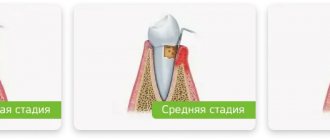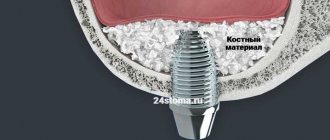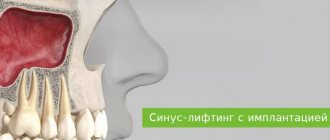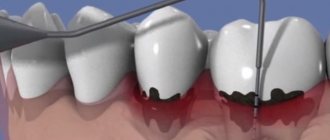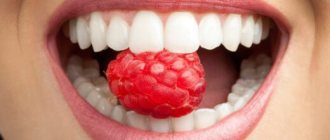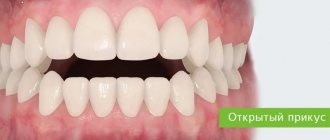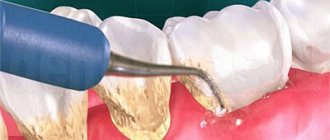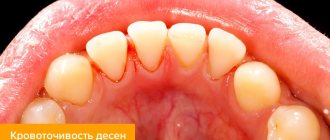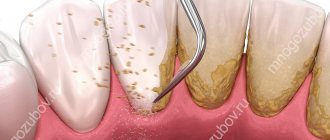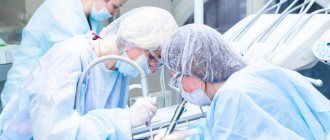From this article you will learn:
- what is curettage of gums and teeth (video),
- methods of its implementation, reviews,
- What is flap surgery for periodontitis?
The article was written by a practicing periodontist surgeon.
Curettage is a surgical technique for the treatment of chronic periodontitis, which involves scraping out the contents of periodontal pockets. Its goal is to remove granulations, subgingival dental deposits, the epithelial lining of the pockets, as well as a layer of necrotic “cement” on the surface of the tooth root from the pockets. This is a fairly complex intervention that requires surgical skills and should ideally be performed only by a periodontal surgeon (oral surgeon).
There are 2 methods of this operation in dentistry. Closed curettage is a technique that is preferred for shallow periodontal pockets up to 4.0 mm (which corresponds to mild periodontitis). Open curettage is a more complex surgical technique, which is indicated in the presence of periodontal pockets with a depth of more than 4.0 mm, i.e. carried out for moderate to severe periodontitis. The open technique requires good surgical skills, because... During the operation, the gums will peel away from the bone tissue around the teeth.
Closed curettage technique –
There is also an even more radical option for open curettage, which is called the term “flap operation” (we will also talk about this in more detail below). The following is a very important point. If the closed curettage technique has the right to be performed by ordinary dental therapists with advanced training in periodontics, then open curettage and flap operations can only be performed by dental surgeons or maxillofacial surgeons.
How to do curettage
Curettage is a surgical operation.
Plaque, stone, and pathological tissue are removed from the periodontal pocket. If necessary, osteoplastic surgery is performed. This is necessary if bone resorption has already begun. Curettage must be carried out in the treatment of periodontitis and periodontal disease, as this is one of the most effective methods for eliminating inflammation in the gums. According to the technology of the procedure, there are two types of it:
- Open;
- Closed.
General information about periodontal diseases
A brief excursion about periodontal disease and its diseases is necessary to understand why curettage is prescribed for certain problems with the gums. So, the tissues that surround the tooth and hold it in the alveolus are called periodontium. For a number of reasons, a pathological process may begin in them, which is a manifestation of gingivitis, periodontitis or periodontal disease (as an aggressive form of periodontitis). With gingivitis, the edge of the gum becomes inflamed, affecting only its mucous membrane. Without treatment, inflammation spreads to the deeper layers of the periodontium, causing deepening of the periodontal (gum) pockets (the gums peel away from the tooth). As a result, the dental unit becomes loose and its neck is exposed. This disease is classified as periodontitis.
Closed curettage
Can be used if the depth of the periodontal pocket does not exceed 5 mm, and pathological changes in the bones have not yet begun. When performing closed curettage, pathological tissues are exposed to ultrasound and hand instruments in the form of hooks, with the help of which granules are removed from under the gums. There is no cutting of the gums, so the procedure can be considered more gentle.
Flaws:
- The doctor performs the operation almost blindly; he does not see the subgingival space. Therefore, it is not possible to thoroughly clean the periodontal pocket in all cases.
- There is a risk of incomplete cleaning. Success largely depends on the experience of the dentist performing the procedure.
Due to its characteristics, closed curettage is suitable for mild to moderate periodontitis and periodontal disease. Sometimes it becomes the only possible method, since others cannot be used for some reason.
What is a periodontal pocket?
Normally, the depth of the gingival groove - the depression between the surface of the tooth and the gum - should not exceed 2 mm. As soft plaque, consisting of food debris and gradually turning into hard deposits, is concentrated in it, a pathological focus is formed. This leads to deepening of the grooves and the formation of periodontal pockets, the presence of which provokes inflammatory processes and the development of caries.
In addition to solid deposits, the formation of pockets can be caused by:
- inflammation of periodontal tissues;
- bite defects;
- Gastrointestinal diseases, metabolic disorders;
- lack of solid food in the diet;
- hormonal imbalances and other factors.
Open curettage
Used if the depth of periodontal pockets is more than 5 mm. This is a surgical intervention, but compared to a closed one, the effectiveness is much higher. Since open curettage requires cutting into the gums, the operation is performed under anesthesia.
Stages:
- The doctor cuts the gum and peels it away from the tooth. After exfoliation, the tooth root is completely exposed. The dentist gets full access to the bone tissue.
- Cleaning and antiseptic treatment. The roots are cleaned of accumulated plaque and stone and polished using a burr and special pastes. After this, the tissues are treated with an antiseptic.
- Osteoplasty. This stage is not always necessary. With advanced periodontal disease, bone resorption gradually begins around the teeth, which will lead to loosening and tooth loss. In order to restore the bone, osteoplastic material is implanted.
- Suturing. After plaque removal, the gingival flap is returned to its place and sutured. A bandage with an antiseptic solution is applied on top.
Open curettage is a more complex procedure, but more effective than closed curettage. The surgeon sees the entire subgingival space and has access to bone tissue. Therefore, the quality is very high; both plaque and granulation tissue are completely removed from under the gums.
If necessary, open curettage can be performed simultaneously with flap surgery. It is indicated if the gum tissue is loose and the gum contour is disturbed. Very often, with periodontal disease, the gums begin to overhang the teeth. This violates the aesthetics of a smile. During flap surgery, the dentist removes excess mucous membrane and then sutures the gum.
Content:
Around each tooth there is a small gingival fold, tightly adjacent to its cervical part, which is called a physiological periodontal (gum) pocket.
With poor dental care or due to hereditary factors, soft plaque accumulates on the teeth, which, under the influence of microflora, turns into hard dental deposits - stones.
Tartar, accumulating on the tooth wall, pushes back the gingival fold, forming a pathological gingival pocket, which causes gum inflammation and bleeding. As a result of inflammation, bone tissue is destroyed, gums swell, bad breath appears, ligaments around the teeth are destroyed, teeth lose support, begin to loosen and eventually fall out.
Rehabilitation
Curettage of periodontal pockets is a surgical operation, after which there will be a period of rehabilitation. Following the recommendations will speed up gum healing, make it less uncomfortable, and avoid complications.
Oral care rules depend on the method:
- Closed curettage. Immediately after surgery, you should not eat for several hours. On the first day, it is better to refrain from brushing your teeth with a brush and toothpaste, replacing it with rinsing. During the entire rehabilitation period, you need to monitor your diet - exclude solid foods and foods containing dyes. After curettage, there may be increased sensitivity of the teeth and gums. A special paste that your doctor will recommend will help you remove it. It is imperative to rinse your mouth with solutions of strengthening and anti-inflammatory medications.
- Open curettage. Since this surgery requires cutting into the gum, recovery takes longer. Recommendations for the first 1-2 days after surgery are the same as for closed curettage. It is very important to minimize the possible stress on the gums and teeth. It is advisable to reduce physical activity at first. Until the stitches heal, your mouth should be rinsed with solutions of antibacterial and anti-inflammatory agents. This will help speed up healing and tissue regeneration.
Indications
Prescribing curettage is possible only after a specialist has carried out diagnostic studies, including fluoroscopy. Based on the results obtained, the doctor will determine the required volume of intervention, choose the method of curettage, and draw up a treatment plan. Common indications for the procedure:
- inflammatory processes;
- abundant hard deposits leading to displacement of natural tissues;
- detected deep periodontal pockets;
- unstable dentition.
Flaws
Gum curettage is a simple dental operation with good results. However, it is not without its drawbacks:
- Traumaticity. Like any surgical intervention, curettage injures soft tissue.
- The need for anesthesia. Normally, the operation is performed under local anesthesia. Sedation or general anesthesia is used in extreme cases or when the patient is in panic.
- Rehabilitation. The gums heal quickly, but at this time it is necessary to follow the recommendations and take care of the oral cavity. Infection of the wound can lead to complications.
Contraindications
Curettage is considered a rather complex operation, which is contraindicated in the following cases:
- abnormally thinned gingival tissues;
- the presence of infectious diseases;
- excessive bleeding gums;
- pocket depth over 6 mm;
- purulent discharge from the pockets, the presence of fibrous changes in them;
- malocclusions;
- individual intolerance to anesthesia.
Every patient is interested in whether it is painful to perform closed curettage of a tooth? This partly depends on the chosen technique and the characteristics of the body, but modern methods of anesthesia make it possible to completely eliminate pain during the procedure. The same applies to a more complex and traumatic type of surgical intervention - open curettage.
Alternatives to curettage
Alternative technologies are suitable as prevention or in the early stages of pathology development. At the Zuub clinic they use:
- Comprehensive teeth cleaning. This is good prevention. It can be used as one of the stages of complex therapy, but not as an independent treatment. During cleaning, using ultrasound and a mixture of water, air and soda, tartar and plaque are removed from the surface of the teeth. You won't be able to empty your pockets this way.
- Treatment with the “Vector” device. A method for cleaning and disinfecting shallow periodontal pockets. In mild stages of periodontal disease, it can be used as an alternative to closed gum curettage, but it cannot replace open vector therapy. "Vector" is more effective than classic complex cleaning. It is based on a combination of exposure to an ultrasonic wave and a special suspension with abrasive particles. Since the ultrasonic wave is applied vertically, it penetrates deeply under the gum. In addition, ultrasound has a good disinfecting effect. Thanks to this, with a small depth of periodontal pockets and an undeveloped pathological process, it can give a good result.
The periodontist selects the gum treatment technology based on the clinical picture.
Come for a consultation with a dentist at the Zuub clinic.
Which treatment method is most effective?
To summarize, it must be said that each of the presented methods has both advantages and disadvantages. Therefore, at the initial stage of periodontitis, closed curettage will be the most effective treatment method. But it is worth remembering that the results of this treatment method are short-lived. Therefore, in the future it may be necessary to repeat this operation several times.
Moderate and severe forms of periodontitis require open curettage or flap surgery. These techniques can guarantee not only the elimination of the problem, but also the prevention of its progression in the future.
Regardless of the chosen treatment method, you need to remember that you should never neglect your dental health. If problems of various kinds arise, you should contact only specialized dental clinics.
Make an appointment with a therapist by phone+7(985)532-21-01
